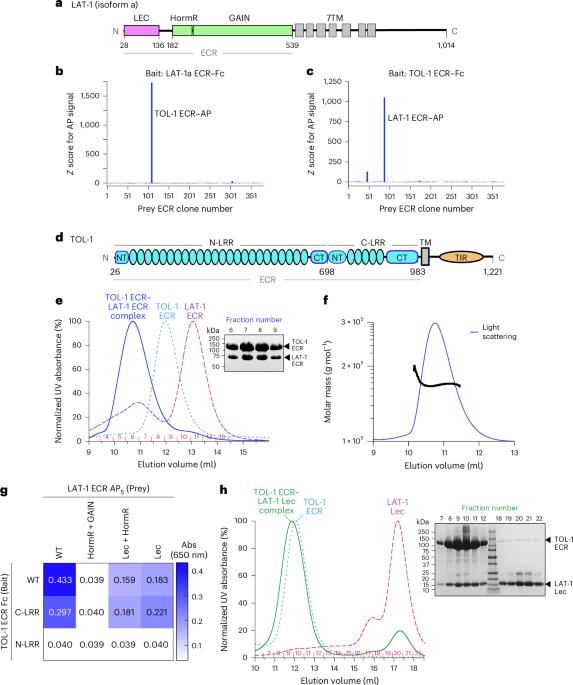toll样受体与嗜Latrophilin结合在秀丽隐杆线虫发育中的结构基础和功能作用
IF 10.1
1区 生物学
Q1 BIOCHEMISTRY & MOLECULAR BIOLOGY
引用次数: 0
摘要
嗜乳蛋白是一种保守的粘附型g蛋白偶联受体,与胚胎缺陷和致死性有关。然而,它们在胚胎发生中的机制作用和配体仍不清楚。在这里,我们发现秀丽隐杆线虫中唯一的toll样受体toll -1是秀丽隐杆线虫嗜碱蛋白lat1的配体。lat1的胞外凝集素结构域直接与tol1的第二个富含亮氨酸的重复结构域结合。lat1 - tol1胞外区复合体的晶体结构和低温电镜密度图显示凝集素结构域与富含亮氨酸的重复结构域的凸面有一对一的相互作用。在秀丽隐杆线虫中,内源性mRNA和蛋白质的定位分析显示出互斥的表达位点,这表明体内lat1 - tol1的相互作用主要发生在反式中。破坏lat1 - tol1相互作用的关键界面残基的突变导致部分致死和胚胎畸形。因此,tol1与lat1结合代表了动物发育所必需的受体-配体轴。本文章由计算机程序翻译,如有差异,请以英文原文为准。


Structural basis and functional roles for Toll-like receptor binding to Latrophilin in C. elegans development
Latrophilins are conserved adhesion-type G-protein-coupled receptors associated with embryonic defects and lethality. However, their mechanistic roles and ligands in embryogenesis remain unknown. Here, we identified TOL-1, the sole Toll-like receptor in Caenorhabditis elegans, as a ligand for the C. elegans latrophilin, LAT-1. The extracellular lectin domain of LAT-1 directly binds to the second leucine-rich repeat domain of TOL-1. The crystal structure and cryo-electron microscopy density map of the LAT-1–TOL-1 extracellular region complex reveal a one-to-one lectin domain interaction with the convex face of a leucine-rich repeat domain. In C. elegans, endogenous mRNA and protein localization analyses showed mutually exclusive sites of expression, suggesting that in vivo LAT-1–TOL-1 interactions mostly occur in trans. Mutagenesis of key interface residues that disrupt the LAT-1–TOL-1 interaction led to partial lethality and malformed embryos. Thus, TOL-1 binding to LAT-1 represents a receptor–ligand axis essential for animal development. Carmona-Rosas, Li and Smith et al. show that two cell surface receptors, latrophilin and Toll-like receptor, interact in Caenorhabditis elegans and mediate strong roles in early development and morphogenesis.
求助全文
通过发布文献求助,成功后即可免费获取论文全文。
去求助
来源期刊

Nature Structural & Molecular Biology
BIOCHEMISTRY & MOLECULAR BIOLOGY-BIOPHYSICS
CiteScore
22.00
自引率
1.80%
发文量
160
审稿时长
3-8 weeks
期刊介绍:
Nature Structural & Molecular Biology is a comprehensive platform that combines structural and molecular research. Our journal focuses on exploring the functional and mechanistic aspects of biological processes, emphasizing how molecular components collaborate to achieve a particular function. While structural data can shed light on these insights, our publication does not require them as a prerequisite.
 求助内容:
求助内容: 应助结果提醒方式:
应助结果提醒方式:


